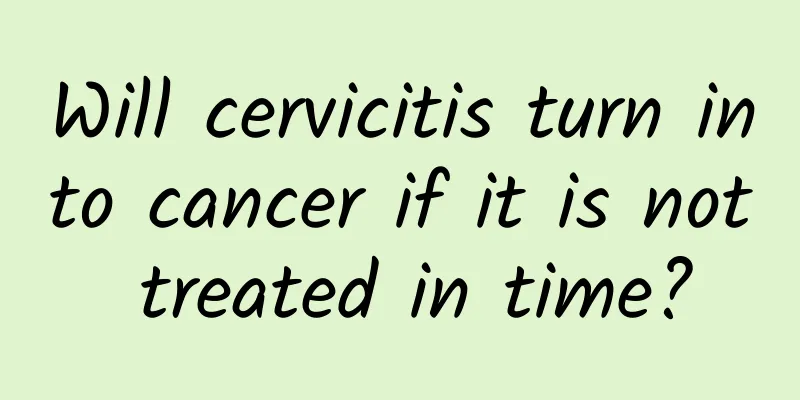Will cervicitis turn into cancer if it is not treated in time?

|
If cervicitis is not treated in time, it may increase the risk of cervical cancer, but not all cervicitis will turn into cancer. Treatment should be based on the cause of the disease, including anti-infection, physical therapy or surgical intervention, while regular screening can effectively prevent cancer. 1. The risk of cervicitis developing into cervical cancer is closely related to persistent infection with high-risk human papillomavirus (HPV). HPV infection is the main cause of cervical cancer. If chronic cervicitis persists for a long time, it may provide a favorable environment for HPV infection and increase the probability of cancer. 2. Treatments for cervicitis include medication, physical therapy, and surgery. Medication is suitable for infectious cervicitis, and commonly used drugs include antibiotics such as azithromycin, doxycycline, and antiviral drugs such as interferon. Physical therapy such as laser, freezing, or electrocautery can be used to eliminate inflamed tissue. For severe cases, cervical conization or hysterectomy may be required. 3. The key to preventing cervical cancer is regular screening and HPV vaccination. It is recommended that women undergo cervical cytology TCT and HPV testing once a year to detect and treat cervical lesions at an early stage. HPV vaccination can effectively prevent high-risk HPV infection and reduce the risk of cervical cancer. 4. Adjusting your lifestyle can also help prevent cervicitis and its complications. Maintaining personal hygiene, avoiding unclean sexual behavior, enhancing immunity, eating a balanced diet, and eating more foods rich in vitamins C and E, such as citrus fruits and nuts, can help maintain a healthy cervix. If cervicitis is not treated in time, it may increase the risk of cervical cancer, but this risk can be effectively reduced through standardized treatment, regular screening and a healthy lifestyle. It is recommended that women pay attention to cervical health, seek medical treatment in time and take preventive measures to ensure good health. |
<<: Is it mycoplasma-induced adnexitis?
>>: Typical symptoms of threatened abortion
Recommend
Will chronic cervicitis cause bleeding in women? How to treat chronic cervicitis bleeding in women?
For married women, irregular cervical bleeding is...
The best hospital for the treatment of endometrial thickening
Currently, the most effective treatment for endom...
Which hospital is best for treating ovarian cysts?
Ovarian cysts are common gynecological diseases. ...
The symptoms of acute and chronic adnexitis are not single
The symptoms of acute and chronic adnexitis are n...
What is the cause of recurrence of candidal vaginitis?
In fact, candidal vaginitis is vaginitis caused b...
Lower back pain and stiff shoulders? Spend 1 minute a day doing squats
Why do you often feel back pain, knee pain, or ev...
What are the causes of pelvic effusion?
Pelvic effusion is a disease unique to women, whi...
What can women eat to prevent uterine fibroids? What can women eat to prevent aging?
What can women eat to prevent uterine fibroids? W...
What causes multiple ovarian cysts?
What are the causes of multiple ovarian cysts? Ov...
How does adnexitis affect female fertility?
Regarding the impact of adnexitis on fertility, I...
There is a reason why it is easy to gain weight! To boost your metabolism, drink the right coffee, chocolate and this soup.
"Foods that increase basal metabolism" ...
Is congenital absence of vagina dangerous?
I believe that everyone is not very familiar with...
6 foods to reduce excess fat! Hollywood actresses teach healthy eating
Although starving yourself recklessly or eating o...
What's wrong with bleeding one week after period?
What's wrong with bleeding one week after per...
Vulvar redness, swelling, burning, abnormal vaginal discharge
Vulvar redness, swelling, and burning accompanied...









